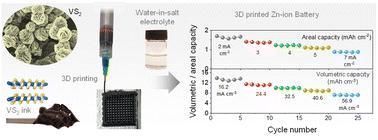当前位置:
X-MOL 学术
›
Nanoscale Horiz.
›
论文详情
Our official English website, www.x-mol.net, welcomes your feedback! (Note: you will need to create a separate account there.)
3D printing of layered vanadium disulfide for water-in-salt electrolyte zinc-ion batteries
Nanoscale Horizons ( IF 9.7 ) Pub Date : 2024-02-29 , DOI: 10.1039/d3nh00576c Stefano Tagliaferri 1 , Goli Nagaraju 1 , Maria Sokolikova 1 , Rachael Quintin-Baxendale 1 , Cecilia Mattevi 1
Nanoscale Horizons ( IF 9.7 ) Pub Date : 2024-02-29 , DOI: 10.1039/d3nh00576c Stefano Tagliaferri 1 , Goli Nagaraju 1 , Maria Sokolikova 1 , Rachael Quintin-Baxendale 1 , Cecilia Mattevi 1
Affiliation

|
Miniaturized aqueous zinc ion batteries are attractive energy storage devices for wearable electronics, owing to their safety and low cost. Layered vanadium disulfide (VS2) has demonstrated competitive charge storage capability for aqueous zinc ion batteries, as a result of its multivalent states and large interlayer spacing. However, VS2 electrodes are affected by quick oxide conversion, and they present predefined geometries and aspect ratios, which hinders their integration in wearables devices. Here, we demonstrate the formulation of a suitable ink for extrusion-based 3D printing (direct ink writing) based on micro flowers of layered VS2 obtained using a scalable hydrothermal process. 3D printed architectures of arbitrary design present electrochemically active, porous and micron-sized struts with tuneable mass loading. These were used as cathodes for aqueous zinc-ion battery electrodes. The 3D printed VS2 cathodes were assembled with carbon/zinc foil anodes to form full cells of zinc-ion, demonstrating a capacity of ∼1.98 mA h cm−2 with an operating voltage of 1.5 V. Upon cycling a capacity retention of around 65% was achieved after ∼100 cycles. The choice of the electrolyte (a water-in-salt electrolyte) and the design of the pre-processing of the 3D printed cathode ensured improved stability against dissolution and swift oxidation, notorious challenges for VS2 in an aqueous environment. This works paves the way towards programmable manufacturing of miniaturized aqueous batteries and the materials processing approach can be applied to different materials and battery systems to improve stability.
中文翻译:

3D打印用于盐包水电解质锌离子电池的层状二硫化钒
小型水性锌离子电池由于其安全性和低成本而成为可穿戴电子产品颇具吸引力的储能装置。由于其多价态和大的层间距,层状二硫化钒(VS 2 )在水性锌离子电池中表现出有竞争力的电荷存储能力。然而,VS 2电极受到快速氧化物转化的影响,并且它们呈现预定义的几何形状和纵横比,这阻碍了它们在可穿戴设备中的集成。在这里,我们展示了一种适用于基于挤出的 3D 打印(直接墨水书写)的墨水配方,该墨水基于使用可扩展水热工艺获得的分层 VS 2微花。任意设计的 3D 打印架构呈现电化学活性、多孔和微米尺寸的支柱,具有可调节的质量负载。这些被用作水性锌离子电池电极的阴极。3D 打印的 VS 2阴极与碳/锌箔阳极组装在一起,形成锌离子全电池,在工作电压为 1.5 V 的情况下,容量保持在 1.98 mA h cm -2左右。循环后,容量保持率约为 65约 100 次循环后达到 %。电解质(盐包水电解质)的选择和 3D 打印阴极的预处理设计确保了改善溶解和快速氧化的稳定性,这是 VS 2在水环境中面临的众所周知的挑战。这项工作为小型水性电池的可编程制造铺平了道路,并且材料加工方法可以应用于不同的材料和电池系统以提高稳定性。
更新日期:2024-02-29
中文翻译:

3D打印用于盐包水电解质锌离子电池的层状二硫化钒
小型水性锌离子电池由于其安全性和低成本而成为可穿戴电子产品颇具吸引力的储能装置。由于其多价态和大的层间距,层状二硫化钒(VS 2 )在水性锌离子电池中表现出有竞争力的电荷存储能力。然而,VS 2电极受到快速氧化物转化的影响,并且它们呈现预定义的几何形状和纵横比,这阻碍了它们在可穿戴设备中的集成。在这里,我们展示了一种适用于基于挤出的 3D 打印(直接墨水书写)的墨水配方,该墨水基于使用可扩展水热工艺获得的分层 VS 2微花。任意设计的 3D 打印架构呈现电化学活性、多孔和微米尺寸的支柱,具有可调节的质量负载。这些被用作水性锌离子电池电极的阴极。3D 打印的 VS 2阴极与碳/锌箔阳极组装在一起,形成锌离子全电池,在工作电压为 1.5 V 的情况下,容量保持在 1.98 mA h cm -2左右。循环后,容量保持率约为 65约 100 次循环后达到 %。电解质(盐包水电解质)的选择和 3D 打印阴极的预处理设计确保了改善溶解和快速氧化的稳定性,这是 VS 2在水环境中面临的众所周知的挑战。这项工作为小型水性电池的可编程制造铺平了道路,并且材料加工方法可以应用于不同的材料和电池系统以提高稳定性。



























 京公网安备 11010802027423号
京公网安备 11010802027423号